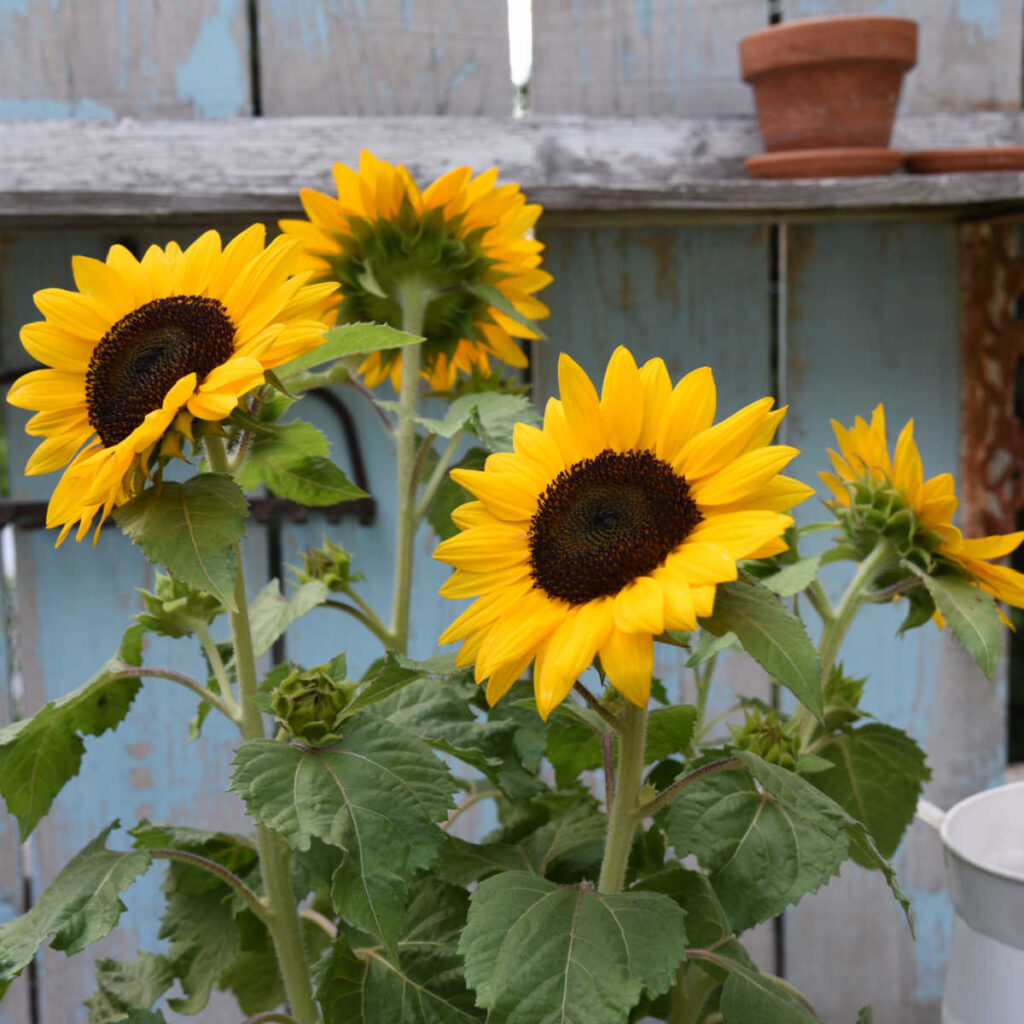Can Sunflowers Grow in Partial Shade?
Sunflowers are iconic summer flowers that are known for loving the sun. Their bright, cheerful faces seem to follow the sun’s path across the sky. However, contrary to popular belief, sunflowers can grow in partial shade. While they prefer full sun, they can adapt to get enough sunlight to thrive in partly shaded areas.
What Does Partial Shade Mean?
Partial shade refers to a location that gets filtered sunlight for part of the day, usually in the morning before the sun gets too intense. Areas with partial shade receive less than 6 hours of direct sun but at least 4 hours daily. The sunlight is often dappled, meaning it filters through the leaves of trees or structures that break up the light.
Dappled shade creates an ideal balance of sunlight and shade for sunflowers. They get sufficient light for photosynthesis and growth while being protected from the harsh afternoon sun Partial shade also helps conserve moisture in the soil
Factors Affecting Sunflowers in Partial Shade
Several factors determine how well sunflowers will grow in partial shade:
-
Sunflower Variety – Some varieties are bred to be more shade tolerant. Choose short, bushy types over tall, single-stemmed ones.
-
Shade Duration – Sunflowers need a minimum of 4-6 hours of sunlight to bloom properly. More shade will limit growth.
-
Light Intensity – Bright dappled light is better than dense shade. Prune trees or use shade cloth to adjust light levels.
-
Soil Quality – Sunflowers need nutrient-rich, well-draining soil. Amend soil with compost to improve moisture retention.
-
Water – Sunflowers need consistent moisture, especially in drier, shadier spots. Mulch and water diligently.
-
Temperature – Cooler temperatures from shade can stunt growth. Pick sunny spots during cooler seasons.
Choosing the Right Sunflower Varieties
The most important factor in successfully growing sunflowers in partial shade is choosing the right variety. Some are naturally more shade tolerant and compact, making them ideal for partially shaded gardens. These include:
-
Dwarf Sunspot – A dwarf variety that grows just 2-3 feet tall with smaller blooms.
-
Little Becka – A compact bush sunflower that reaches 2-3 feet. Blooms are 3-4 inches across.
-
Floristan – A dwarf, multi-branching sunflower that grows to just 16 inches tall.
-
Musicbox – A dwarf variety that grows 2 feet tall on sturdy stems with bright lemon-yellow petals.
-
Soraya – A dwarf sunflower that stays under 3 feet tall with unique bicolor blooms in sunset shades.
-
Suntastic Yellow – A compact, bushy sunflower with vibrant golden blooms. Grows to just 2-3 feet tall.
-
Sunbeam – A dwarf sunflower with a bushy habit and golden-orange flowers. Just 1-2 feet tall.
Positioning Sunflowers in Partial Shade
Once you’ve selected the right sunflower varieties for partial shade, it’s important to position them carefully within your garden. Choose spots that will give them the best chance of getting sufficient sunlight.
The ideal position is one that gets at least 4 hours of morning sunlight. This allows the sunflowers to soak up sun during the coolest part of the day while being shaded from the intense afternoon rays.
East-facing spots are perfect, followed by locations with southern exposure. If planting near trees, place sunflowers on the south or east side of the canopy where they’ll get the most early light penetration. Avoid planting on the north side of buildings or trees.
You can also use strategically placed reflectors, trellises or other plants to direct and maximize the sunlight that reaches your sunflowers. Observe the light patterns in your garden and adjust plantings accordingly.
Caring for Sunflowers in Partial Shade
Sunflowers grown in partial shade need a bit of extra care and attention to help them thrive:
-
Water frequently – Shade causes soil to dry out slower but sunflowers still need moisture. Water when top 1 inch is dry.
-
Mulch around plants to retain moisture and reduce weeds competing for water.
-
Use fertilizer to provide extra nutrients needed to produce blooms in shade.
-
Stake plants if needed to prevent spindly stems from toppling over in shade.
-
Prune off lower leaves to encourage air circulation and reduce fungal issues.
-
Control pests like aphids that can spread quickly on weakened plants.
-
Rotate spot each year to allow soil to replenish nutrients.
With the right variety choice, positioning, and care, it is possible for sunflowers to produce abundant blooms even in partially shaded garden spots. Pay close attention and make adjustments to ensure your sunflowers get the sunlight, moisture, and food they need to thrive in the shade.

From Seed to Sunflower: How to Grow These Stunning Blooms!
I remember the first time I grew sunflowers in my garden; those bright yellow petals and tall, sturdy stems felt like they brought a bit of sunshine right into my yard. Sunflowers are such a gorgeous sight in the summer, and growing them turned out to be a simple and rewarding project—one that anyone can take on, no matter their gardening experience.
In this post, I’ll share everything I learned about growing sunflowers from seed. I’ll walk you through when to plant them, the best spots in your garden space, tips for caring for these sun-loving giants, and even how to harvest your own sunflower seeds.

This post contains affiliate links. If you make a purchase after clicking a link I may make a small commission at no cost to you.
When to Plant Sunflower Seedlings
Sunflowers are an annual plant that grows best in warm weather. The ideal time to plant sunflower seeds directly in the garden is in the late spring or early summer, once the danger of frost has passed and the soil has warmed up.
Depending on your location and climate, this could be any where from April to June. If you live in a cooler climate, you may want to start your sunflower seeds indoors a few weeks before the last frost date and transplant them outside once the weather has warmed up.
Sunflower seedlings can be planted out after the danger of frost but starting them indoors gives everyone a jumpstart on flowering.
How to Grow Sunflowers Successfully At Home
FAQ
How much sunlight do sunflowers require?
Sunflowers need full sun; see 6-8 hours of direct sunlight per day – the more the better if you are trying to grow them to their maximum potential. Choose a well-drained location, and prepare your soil by digging an area of about 2-3 feet in circumference to a depth of about 2 feet.
What happens if sunflowers don’t get enough sun?
When the Common sunflower does not get adequate sunlight, or they are not placed in full sun locations, it’s worth noting that the photosynthetic process will slow down. A lack of sunlight will cause the stems to become more leggy since they become thin and long since they tend to seek too much sunlight.
Where should you not plant sunflowers?
“Sunflowers release allelopathic chemicals that can inhibit the growth of nearby plants, such as potatoes and beans,” explains Janney. She also recommends avoiding plants with shallow root systems, since they will compete for nutrients and water, and plants that will be stunted by the shade of tall-reaching sunflowers.
What side of the house should I plant sunflowers on?
Fun Fact: Sunflowers’ botanical name is as evocative as their common one: Helianthus derives from Greek for sun (helios) and flower (anthos). Line sunflowers along the west or south side of your home.Mar 3, 2024
Can sunflowers grow in shade?
Sunflowers can grow in shade areas, but don’t expect a bountiful harvest if you do that. For the best results, a sunflower needs 6 to 8 hours of sunlight. Therefore, you should plant sunflowers in an open area where they receive abundant sunlight from morning to evening. What Happens When You Plant Sunflowers in Shade?
Do sunflowers need full sun?
Sunflowers need full sun to grow and bloom, but they can also be cultivated in partial shade with the right conditions. If you don’t have many options on where to plant your sunflowers, you must pick a spot with at least four hours of direct sun each day. However, you need at least six hours for optimal growth.
What are the disadvantages of planting sunflowers under shade?
One of the disadvantages of planting sunflowers under shade is exposing them to diseases. A fungal disease such as Phoma blight thrives in wet conditions. Therefore, if your plant is not getting enough sunlight, it may be attacked by this fungal disease. Phoma blight attacks the plant when it starts flowering.
Can you grow sunflowers in the ground?
Growing sunflowers in the ground is equally as easy as in pots. Some gardeners favour this way over growing them in pots but then you lose out on growing them indoors with the children whilst the weather is still cooler outside. You will want to sow your sunflower seeds when the soil has warmed up and the risk of frost has passed.
How long does it take for a sunflower to grow?
However, you need at least six hours for optimal growth. Select dwarf varieties that are more suitable for partial shade. These include ‘Autumn Beauty,’ ‘Teddy Bear,’ and ‘Mauve Mist,’ which are smaller than traditional sunflowers but still produce beautiful blooms.
How many seeds does a sunflower need to produce?
As a result, it will lead to stunted growth. The plant will be weak and unhealthy. If sunflower is grown within the right conditions, it should produce at least 1, 000 seeds.
